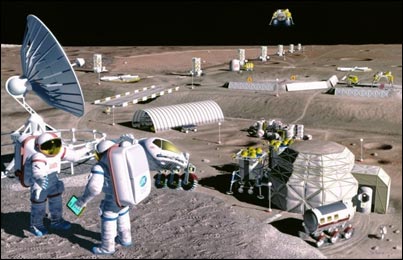
Team 06-0001

|
 |
Water on the Moon?

Image from: http://www.x-panded.com/pixeldam/indexpixelmoon.html
As typical people, we have a need to explore, and satisfy our curiosity. We have all heard the saying that curiosity killed the cat, but satisfaction brought him back- and it is very true in the case of going to the moon, with robots or people, and searching its surface for water. We are willing to risk lives in this endeavor, with the hope that scientific information, satisfying our curiosity, will make it worth it.
Mankind has talked of colonizing the moon for quite a long time. However, the logistical problems of living on the moon for long periods of time are a nightmare. The main logistical problem is water, the substance necessary for life itself to even exist. Rocketing water supplies to the moon is extremely expensive, as water weighs in at around eight pounds per gallon and a small supply of 1000 gallons of water would weigh 8,000 pounds!
Imagine we find that there is water ice on the moon in large quantities. It would change our lives forever, because our generation could begin to spend longer periods of time exploring the moon at once- a major cost saver, since a majority of the cost for our moon missions is building the shuttle and getting there- and possibly start colonies there.
Nasa's Plan for the Moon
This is NASA's plan for returning to the moon, as quoted from http://www.nasa.gov/pdf/55584main_vision_space_exploration-hi-res.pdf [5]:
• Undertake lunar exploration activities to enable sustained human and robotic exploration of Mars and
more distant destinations in the solar system;
• Starting no later than 2008, initiate a series of robotic missions to the Moon to prepare for and support
future human exploration activities;
• Conduct the first extended human expedition to the lunar surface as early as 2015, but no later than
the year 2020; and
• Use lunar exploration activities to further science, and to develop and test new approaches,
technologies, and systems, including use of lunar and other space resources, to support sustained
human space exploration to Mars and other destinations.
This web site will give you information on the history of lunar rovers, an overview of the terrain of the target area, we will explore the differences between a lunar rover and the Martian MER rovers and present a solution to finding water on the moon.
How to use this web site:
In order to navigate this web site please use the image map of the moon on the left side of the web page. In order to use the image map you must have Javascript turned on. If the image map does not work in your browser you may use the navigation bars, located at the top and bottom of each page to navigate the web site.